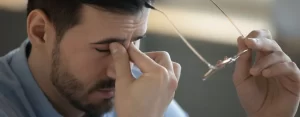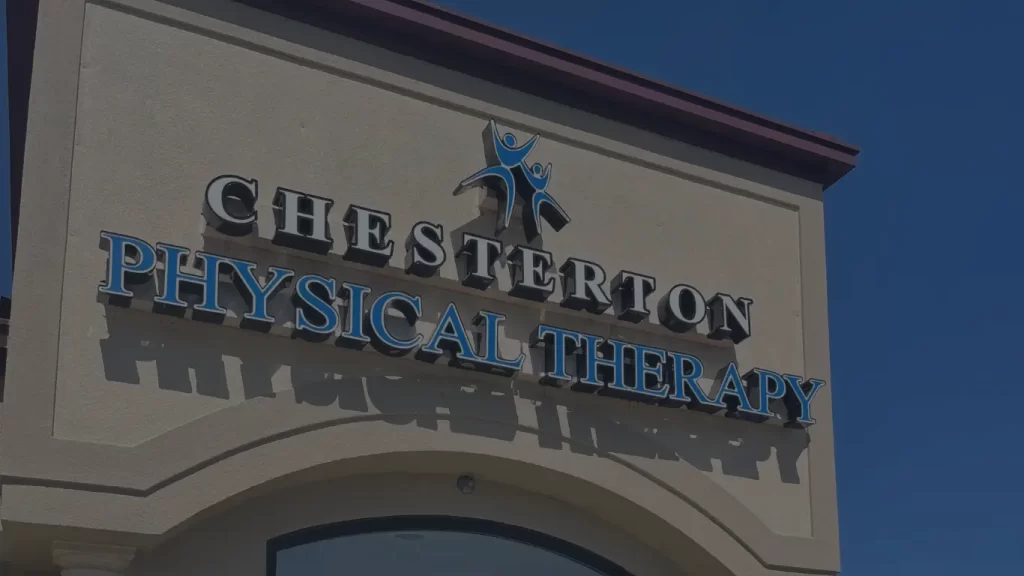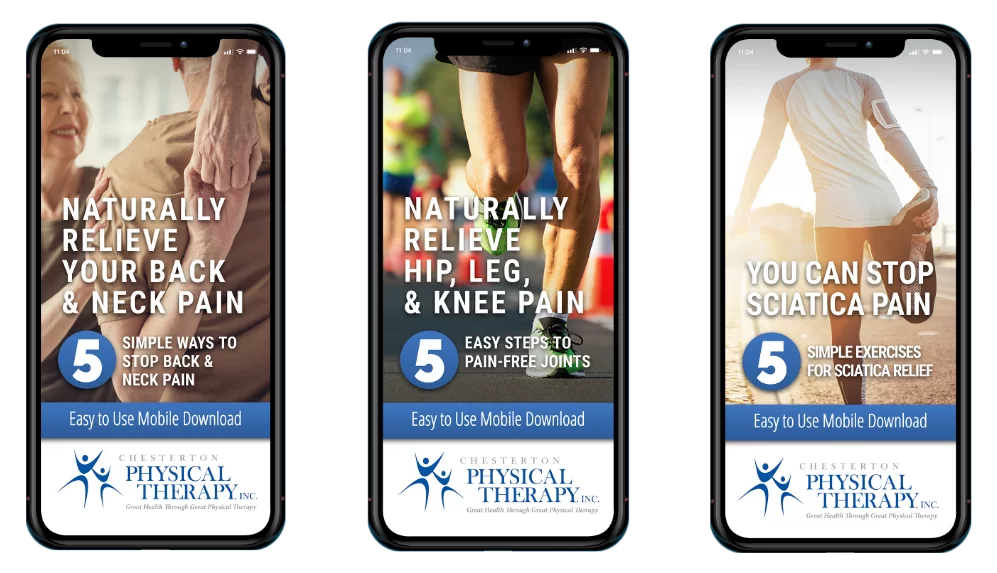Health Blog

Stress-Related Headaches Can Be Bothersome – Fortunately, PT Can Help
Stress-Related Headaches Can Be Bothersome – Fortunately, PT Can Help Discover Relief for Your Headaches Today! Headaches are a common issue that can plague everyone from pre-teens to retirees. However, when recurrent tension or stress-related headaches make it difficult to get through your day, physical therapy may be needed to provide long-lasting pain relief. Physical therapy can help you overcome stress-related headaches. In fact, as stated by Choose PT, “There is an effective treatment for almost every type of headache.” Working with a physical therapist can help you identify tension-reducing exercises and help you find long-term relief from headaches without the need to rely on pain medication. Our innovative care strategies at Chesterton Physical Therapy will help you find quick relief. Our experienced physical therapists have the skills needed to target the root cause of your headaches. Additionally, they can create a tailored treatment plan that is safe and effective. Tired of dealing with irritating and painful headaches? Keep reading to learn how to benefit from physical therapy. Why am I experiencing headaches? The most common type of headache experienced by adolescents and adults in tension headaches—sometimes referred to as stress-related headaches. This type of headache occurs when the muscles of the scalp and neck are tensed and then contracted. Stress is the easy answer to this question, but in reality, it’s a lot more complicated than that. Stress can manifest itself in all kinds of ways; however, finding ways to deal with stress is not always an option. Stress can build from a wide range of activities, and some of those activities may be things that you really enjoy doing, but that doesn’t mean that they don’t weigh on you, creating an added level of pressure that can manifest in painful headaches. If you have tension headaches, you will most likely feel that the pain begins at the back of your neck before it rises to the top of your head and eventually causes pain and discomfort behind your eyes. It’s also common to experience tension headache pain in your cheeks, jaw, and even down your shoulders. Some common causes of a tension headache include: Anxiety and depression Fatigue Arthritis Poor posture Hair pulled back tightly Stress Other common types of headaches that may cause recurrent pain and discomfort include sinus headaches, caffeine headaches, migraine headaches, hormonal headaches, post-traumatic headaches, and cluster headaches. Stress is a common trigger for tension and migraine headaches. Rather than stressing ways you can avoid stress, it may be more helpful to think about strategies that will help ease headaches once you develop—as well as stress-reduction techniques that may prevent stress from reaching your head first. How can a physical therapist help? Physical therapy can help to reduce the pain associated with headaches while working to restore proper function and a full range of motion in the neck and shoulder areas. Typically, there are 2 different types of physical therapy treatments that are ideal for relieving chronic headaches, these include: Active Therapies Range-of-motion exercises Low-impact aerobics Pain relief exercises Muscular releases Strengthening exercises Stretching Passive Therapies Soft tissue mobilization Ultrasound Transcutaneous electrical nerve stimulation or TENS Ultrasound Massage therapy Alternating heat and ice therapy Depending on the severity and cause of your headaches, our physical therapist may suggest a combination of physical therapy treatment methods to provide pain relief. However, because each person responds differently to headache pain, it’s important to keep in mind that there is no “one size fits all” treatment plan. Because physical therapy targets the muscles and joints, it is an effective treatment option for those who experience tension headaches or stress-related headaches, and headache pain that radiates down into the jaw, neck, and shoulder areas. Over time, our physical therapist aims to not only reduce your pain but hopefully prevent recurring headaches altogether. The primary goal of physical therapy is to not only provide pain relief but to increase mobility, improve posture, and help strengthen the muscles that control your neck, shoulders, and upper back areas. With all physical therapy treatment plans, our patients will receive helpful educational information that will help them to complete pain relief exercises at home to supplement in-office visits. Consult with a physical therapist today! If you or your loved one have had recurrent headaches, you can find quick and effective pain relief with regular physical therapy. Are you interested in learning more about the many benefits of physical therapy for tension headaches? Call us today or visit our office in Chesterton, IN and be sure to schedule an initial consultation with one of our friendly physical therapists!

Chronic Back Pain: Physical Therapy, Unlocking New Potentials
Physical Therapy Can Help with Chronic Back Pain! Don’t Live in Discomfort Any Longer Discover Relief for Your Aches and Pains Today Chronic back pain is a pain that lasts for three months and is longer. This type of pain can occur for a variety of reasons, including spinal arthritis, aging, disc problems, and myofascial pain syndrome. With spinal arthritis, the slow thinning of the cartilage inside the spine can result in pain. With a herniated or bulging disc, compression may occur around your surrounding nerves, resulting in pain. With spinal stenosis, there is a narrowing of the spine, which can lead to nerve pain. With myofascial pain syndrome, you may experience unknown muscle tenderness and pain. Our innovative care strategies at Chesterton Physical Therapy will help you find quick relief. Whatever the cause of your pain, it doesn’t have to be a part of your daily life. What can physical therapy do for my chronic pain? If your back pain is caused by spinal stenosis or a bulging disc, a physical therapist may initiate a targeted movement program to reduce numbness, pain, or weakness. Progressive movement exercises such as McKenzie exercises may be included in your physical therapy program to treat a wide range of causes of back pain. Stabilization exercises to retrain deep muscles may also be included. Your physical therapist will also show you how to use the right spinal and abdominal muscles before starting any exercise to stabilize the spine. Manipulation is another technique for alleviating chronic pain where short and rapid movements are performed over the joint to reduce pain and increase mobility. Physical therapists also use multiple passive modalities to reduce back pain. Heat and cold therapy may be used to increase blood flow, reduce inflammation, and relieve pain. Ultrasound is another common passive modality used by physical therapists that incorporates deep heating sound waves that penetrate soft tissue. Not only does this method relieve back pain, but it also aids in the healing of the affected area. A physical therapist may order a transcutaneous electrical nerve stimulation (TENS) unit. This unit helps to overcome the painful signals sent to the brain. It can be used both at home and in the long term. Deep tissue massage is another common therapy for chronic back pain. This manual method increases oxygen and nutrients to the affected areas for healing and also helps reduce muscle spasms and stiffness. According to the NCBI, “In chronic low back without serious pathology, recommended primary conservative physical treatment preferences include exercise, yoga, biofeedback, progressive relaxation, massage, manual therapy, physical therapy and interdisciplinary rehabilitation. A recent literature review with meta-analysis in patients with chronic lower back pain found moderate- to high-quality evidence that McKenzie exercises in physical therapy were superior to other rehabilitation interventions in reducing pain and disability.” What else should I know? As stated by the National Institute of Neurological Disorders and Stroke, “While acute pain is a normal sensation triggered in the nervous system to alert you to possible injury and the need to take care of yourself, chronic pain is different. Chronic pain persists. Pain signals keep firing in the nervous system for weeks, months, even years. There may have been an initial mishap — sprained back, serious infection, or there may be an ongoing cause of pain — arthritis, cancer, ear infection, but some people suffer chronic pain in the absence of any past injury or evidence of body damage. Many chronic pain conditions affect older adults. Common chronic pain complaints include headache, low back pain, cancer pain, arthritis pain, neurogenic pain (pain resulting from damage to the peripheral nerves or to the central nervous system itself), psychogenic pain (pain not due to past disease or injury or any visible sign of damage inside or outside the nervous system). A person may have two or more co-existing chronic pain conditions. Such conditions can include chronic fatigue syndrome, endometriosis, fibromyalgia, inflammatory bowel disease, interstitial cystitis, temporomandibular joint dysfunction, and vulvodynia. It is not known whether these disorders share a common cause.” Chronic pain affects every person differently. In many cases, the pain continues long after the body is healed from the injury or surgery. The good news is that physical therapy is not a one-size-fits-all approach to pain relief. Your physical therapist has many tools and techniques at their disposal to help relieve and overcome chronic pain. Chronic pain has a number of symptoms associated with it, apart from the fact that it lasted more than three months. Here are some of the symptoms commonly associated with chronic aches and pain: Decreased activity: Inactivity due to chronic pain can cause your muscles to weaken and shrink. This can have profound physical effects over time, such as impacting your sense of balance. Decreased circulation: Remaining inactive due to chronic pain reduces your circulation, which means your cells are not receiving a healthy amount of blood and oxygen. This can cause tissues to degenerate and leads to feelings of constant fatigue. Avoiding activities: People with chronic pain become fearful of normal activities. The fear of additional pain can cause people to withdraw from normal physical activities that they enjoy. Stiffness: Muscles and joints may feel stiffer when suffering from chronic pain. Increased weight: People with chronic pain may put on too much weight, which can lead to a host of added problems, from diabetes to heart disease. Ready to find relief? If you have back pain, it’s time to take action. Schedule a physical therapy assessment today. Your physical therapist will work with your doctor to develop a personalized treatment plan for your specific condition. With both active and passive treatment methods, you will be on the road to pain reduction or even elimination. At the end of the road, you will be able to move about your daily life with reduced or no pain in your regular activities!

Are You Battling Opioid Addiction? There’s A Better Option Available!
Are You Battling Opioid Addiction? There’s A Better Option Available! If you are suffering from arthritis, particularly in a weight-bearing joint like the knee or hip, taking an opioid painkiller for relief can be a powerful temptation for you. All you want is for the pain to subside so that you can get on with your day, right? Unfortunately, although opioids can temporarily relieve pain, your bones will continue to grind together, making the underlying cause of the condition even worse. Opioids don’t cure the source of your pain, they only mask it. So, rather than turning to opioids for your arthritis, consider the chemical-free alternative to arthritis pain: physical therapy! Call our office to learn more about how working with a physical therapist can relieve your arthritis or other pain symptoms so that you can stop relying on harmful medications to get through the day. How do I know if I have arthritis? Arthritis is a very common condition that many individuals of all ages suffer from. Arthritis symptoms can be managed with the help of physical therapy. Some of the most common symptoms that arthritis sufferers have to deal with include: Inflamed tissues: The pain and inflammation associated with arthritis can cause tissue swelling near the impacted joint. The area surrounding the joint might feel warm to the touch. Sensations of “grinding”: Arthritis is a result of lost cartilage, the material in the joints which acts as a cushion and lubricant between bones. The loss of cartilage can make it feel as if the patient’s bones are grinding together when they move. Decreased mobility: An arthritic joint can restrict your range of motion, to the point where you are unable to carry out daily tasks like you used to. This can make doing the simplest of things difficult and frustrating. Joint stiffness: The joints are especially stiff when you wake up for the day and may feel sensitive or painful when touched. Pain: To put it simply, arthritic joints may hurt during or after physical movement. Why are opioids so harmful? In a study published by the American Physical Therapy Association, titled “Beyond Opioids: How Physical Therapy Can Transform Pain Management and Improve Health,” the issue of opioid abuse is discussed. It identifies three important events that triggered what the medical community identifies as the “opioid epidemic:” Increases in deaths involving prescription opioids starting in 1999 Increases in deaths involving heroin starting in 2010 Increases in deaths involving synthetic opioids since 2013 Both opioid prescription rates and deaths from opioid overdoses have quadrupled in the last twenty years. Given these stark statistics, an obvious conclusion can be made: Opioid dependence has gotten out of hand, and the consequences can be literally fatal. Beyond extreme physical risk, over-reliance on prescription painkillers can have other detrimental effects on your health. Opioid use can lead to depression, which sets up a vicious cycle of self-medicating in order to feel better emotionally as well as physically. The Centers for Disease Control offers some frightening statistics from opioid overuse in 2011: Sales of prescription painkillers to pharmacies and providers had increased 300% since 1999 In 2010, 12 million people ages 12 and older reported using prescription painkillers “non-medically” More than 40 people were dying each day from overdoses involving prescription opioids You might be thinking, if these medications are harmful, what other options do we have in order to combat chronic pain? There’s an answer: physical therapy. If you have been struggling with pain or discomfort, contact us today to find out how we can resolve your issues the natural way. How can physical therapy provide better relief? If you have been diagnosed with arthritis, you can work with a physical therapist to learn strategies that will help you manage your symptoms, without having to resort to painkillers. During your first appointment, be prepared to talk about your medical history with your therapist. You will be asked to describe your symptoms and how they impact your daily life. For example, does your arthritis prevent you from taking your dog on long walks? Are you no longer able to play weekend basketball with your friends? Your therapist will likely have you do a few simple tests which will vary based on which joints are suffering from arthritis. In general, expect to be tested on your range of motion in the impacted joints, as well as your strength and balance. These tests will be used to determine how far the arthritis has advanced, and to assist the physical therapist in crafting the best possible plan of treatment for you. What techniques will a physical therapist use? Body mechanics will be another part of your arthritis treatment. Your physical therapist will teach you the proper way to carry out daily activities with minimal impact on your arthritic joints. This helps to prevent the grinding sensation and helps prevent the arthritis condition from worsening. Manual therapy will likely be a part of the treatment strategy for managing your arthritis. This specialized type of therapeutic massage not only relieves stiffness and pain in arthritic joints but can also help to loosen tissues up and extend your range of motion. All licensed physical therapists are trained in the use of manual therapy for arthritis. Depending on the location of your arthritis, your therapist might recommend aquatic exercise in a pool for joint relief (as one possible example). The goal will be to increase your strength so that muscle structures can bear your weight better, without putting undue strain on arthritic joints. Exercise and weight management may also be a part of your course of physical therapy. Kick the pain meds today — call our office Physical therapy can help you manage the pain of arthritis without turning to powerful opioids or other painkillers. Call our office today to schedule your first appointment with a licensed physical therapist. Sources: https://www.healthline.com/health/arthritis https://www.apta.org/uploadedFiles/APTAorg/Advocacy/Federal/Legislative_Issues/Opioid/APTAOpioidWhitePaper.pdf

3 Reasons To Add Stretching Into Your Daily Routine!
3 Reasons To Add Stretching Into Your Daily Routine! You might not think about it, but there are many simple physical motions you can do every day that will dramatically improve your overall health, wellness, and quality of life! Stretching happens to be one of them. These exercises are a staple of physical therapy, a natural and safe way to gain relief from chronic pain symptoms. You might be surprised to discover just how many ways stretches can help you. Some of them you may already do! Here is more information about the importance of stretching, as well as some prime reasons that a physical therapist might prescribe stretches to enhance your life at Chesterton Physical Therapy. Why it’s important to stretch daily The key to good health is to keep your body flexible. Many common aches and pains stem from tight muscles and poor movement. Stretching helps your circulatory, respiratory, lymphatic, and musculoskeletal systems. Normal blood and lymphatic fluids circulate the body easier, oxygenating your tissues properly when your tissues are flexible. This helps you feel energized, relieves pain, and allows you to perform daily tasks without feeling tired. It’s no surprise then that stretching is necessary for dedicated athletes, gym warriors, or anyone looking to improve their physical performance. After a workout, you may not feel the need to stretch if your muscles aren’t aching or sore. You still need to! There are several potential effects of not taking the time to stretch correctly after exercise; you could hurt yourself. You might experience stiffness if you’re not stretching adequately. Muscles and tendons that aren’t stretched properly after exercise may be more susceptible to injury. 1. Stretching is a stress reliever Stretching provides numerous benefits to help your body keep itself healthier. One of the most important of these is stress relief. Everyday life throws lots of challenges at you, and the resulting stress can be held in your muscles. You might not realize how much stress you’re carrying until you begin to stretch. Stress in your muscles leads to tightness, spasms, and chronic discomforts such as headaches and neck pain. Stress also floods your body with “fight or flight” hormones such as cortisone and adrenaline. These imbalances can suppress your immune function, making you more vulnerable to viruses and other diseases. Hypertension is yet another dangerous consequence of chronic stress. Regular stretching helps your body release all that pent-up stress. By relaxing and loosening your muscles, you can maintain better control over your blood pressure, avoid chronic muscle pain, and keep your immune system ready for anything. 2. Stretching improves tissue health Tissues that are tight, stiff, or generally unprepared for challenges may tear, resulting in a strain or sprain that puts a premature end to your participation. Stretches provide a safe, gentle way to work out the kinks and get your tissues ready for action. As you become more limber, you reduce your risk of a soft tissue injury. You’ll find those tissues more capable and responsive as you work or play. You’ve probably seen athletes go through sets of stretching exercises before a competition or training session. They’re not just stretching for the fun of it — they’re trying to optimize their athletic performance while also protecting themselves against injury! Stretching after your activity is just as beneficial; it prevents your muscles from seizing up and getting stiff once they’re no longer being exerted. 3. Stretching improves your mobility Stretching becomes even more important when you’ve become less mobile due to issues such as osteoarthritis. The less you move your joints, the greater the likelihood that your muscles and connective tissues will become shorter and more painful. It’s quite common for a physical therapist to prescribe various stretching exercises to individuals suffering from chronic pain conditions. This change obviously limits your joint motion even further and leaves you in even more pain. Stretches naturally support physical therapy recommendations such as walking, heat therapy, or massage therapy in increasing blood flow to painful joints and widening your pain-free range of motion. Chronic pain syndromes often involve tight muscles. Syndromes such as fibromyalgia and myofascial pain syndrome cause muscle knots that limit muscle motion and trigger referred pain to other parts of the body. Regular stretching can help you “untie those” painful knots — all you have to do is consult with a physical therapist to learn more about the best kinds of stretching for your body type and condition! Ready to get started? Contact us today There’s a good reason we suggest visiting a physical therapist to learn more about stretching. There are right ways and wrong ways to stretch! For one thing, different kinds of stretches offer different benefits. Your particular situation might call for active stretches (in which you move a body part with no assistance), passive stretches (in which the body part is held or supported), or both. Our physical therapist can help you stretch safely and effectively — so contact us or visit our physical therapy center in Chesterton, IN today!

Are You Constantly In Pain? It May Be Time To Change Your Diet To reduce Inflammation
Are You Constantly In Pain? It May Be Time To Change Your Diet To reduce Inflammation Inflammation is a natural process the body uses to protect itself and to promote healing. During the inflammation process, your body increases its production of white blood cells. Chronic inflammation, however, can damage the body. Living with continual inflammation can cause pain, swelling, and redness in the affected areas. It can also increase your risk of diabetes, cancer, heart disease, and stroke. There are several ways you can improve your nutrition and decrease pain and inflammation, however. Are you ready to say goodbye once and for all to your chronic aches and pains? If you’re nodding your head yes, keep reading to learn more about how physical therapy and attention to nutrition can help! What is inflammation? Inflammation is the body’s natural response when it’s trying to heal or protect itself. This, of course, is usually a good thing! This is why some people choose to feel their pain and ride it out instead of grabbing an over the counter NSAID. However, inflammation is harmful when it becomes a chronic condition. Pain and inflammation are often connected. Your immune system can naturally respond to injury, ailment, or other harm through inflammation. If you have an infection, wound, tissue damage, or buildup of toxins in your body, the immune response is triggered to deal with it. Without inflammation, injuries wouldn’t be able to heal; however, if this process goes on for too long, Harvard Health, states that it can lead to a variety of health ailments such as heart disease, diabetes, and even some kinds of cancer. If you experience persistent pain that is keeping you from living life as you normally would, it is wise to contact a physical therapist as soon as possible, as it may mean that the inflammation has become chronic. The importance of physical therapy and nutrition Traditionally, chronic inflammation has been treated through bed rest and medication. However, a lack of exercise can make inflammation worse, as it constricts joints and causes muscles to stiffen. Although it might be hard to make yourself get up and move when you’re in pain, it’s normally the best option. Additionally, medications come with a whole slew of side effects, some of which can be dangerous and/or habit-forming. Luckily, pain and inflammation can be treated in much easier and healthier ways – such as diet and physical therapy! Why choose physical therapy? Physical therapy, combined with good nutritional habits, can greatly reduce or even eliminate your pain and inflammation. The American Physical Therapy Association states that the connection between pain and nutrition is strong enough that nutritional screening is often recommended. A physical therapist can provide nutritional guidance along with creating an exercise program that targets and reduces the pain and inflammation you’ve been experiencing. A physical therapist might even recommend activities such as swimming or simple stretching to increase joint flexibility and range of motion. Good nutrition along with a physical therapy treatment plan can help you manage or even eliminate chronic pain by increasing the strength in certain muscles and improving joint stability. How can nutrition provide pain relief? A few foods that can cause inflammation and should be avoided or limited include the following: Soda – Drinking water or tea in place of soda will not only help reduce pain and inflammation but may also help you shed a few pounds. Soda can increase levels of uric acid. This often causes an increase in inflammation and even insulin resistance. Fried foods – Eat your veggies raw, steamed, or baked for the most health benefits. Everything from fried chicken to deep-fried veggies can contribute to inflammation. Refined carbohydrates – Pasta, pastries, white bread, and white flour are all refined carbs that should be eliminated or eaten rarely. Refined carbs include grains that have had most of the fiber and nutrients taken out. Red meats – Protein builds muscle and cartilage. Red meat, especially meats that are processed, can lead to increased inflammation. Healthy, lean protein is a crucial component when creating a diet to reduce pain and inflammation. Chicken is often considered neutral, while many types of fish fight pain and inflammation in the body. Just like there are plenty of foods to avoid because they cause inflammation, there are plenty you can start to incorporate into your diet to fight or decrease inflammation! Some of them are: Berries – Strawberries, blackberries, blueberries, and raspberries are all good choices. Berries have an abundance of antioxidants that can eliminate inflammation. Fatty Fish – Wild-caught salmon, sardines, and mackerel are great sources of Omega-3s, which can fight inflammation. They may even limit stiffness in the joints that is sometimes associated with rheumatoid arthritis. Olive oil – Olive oil is a monounsaturated fat that tastes great on salads and in cooked meals, and it can help reduce inflammation. Make sure to select olive oil that is extra virgin in order to receive the most health benefits. Green Tea – Green tea is rich in polyphenols and antioxidants that can reduce inflammation. When preparing green tea, use water that’s not higher in temperature than 160 degrees since boiling water may destroy many of the antioxidants. Leafy green vegetables – Almost all fruits and vegetables contain what is called phytonutrients that can help fight inflammation, so pick up some kale or spinach to go into a salad the next time you’re in the produce section. It’s time to get your health back on track Instead of relying on surgery or pain medication, consider improving your diet or beginning a healthy physical therapy program customized to meet your specific needs. Put together, these two things can seriously change your life, and help you to live pain-free. Sources: http://www.apta.org/blogs/PTTransforms/2016/11/16/nutrition/ https://www.health.harvard.edu/staying-healthy/foods-that-fight-inflammation

Chronic Pain Controlling Your Life? It’s Time For a Solution
Chronic Pain Controlling Your Life? It’s Time For a Solution Did You Know PT Can Help Even the Most Persistent Pain? Did you know that approximately 80 percent of Americans have experienced (or will experience) chronic back pain? That’s a depressing statistic, especially if you’re already one of those sufferers. Chronic back pain can prevent you from performing the countless daily tasks you need or want to perform. Even when you’re not engaged in activity, your back pain may be keeping you miserable 24/7. But don’t assume that drugs can provide more than temporary relief, or that surgery won’t create more problems than it solves. Instead, go with the healthy, natural way to kiss your back pain goodbye — through physical therapy. What is chronic pain? Chronic back pain refers to pain that lasts more than three months. It is a progressive pain that gradually worsens with time and basic daily activities. Furthermore, the specific cause of back pain may remain unknown. A person simply may not know what caused it or pinpoint a point of origin. However, most people can recover from back pain by understanding its causes, especially those that do not derive from an incident, such as a car accident. Chronic back pain Chronic back pain may arise from two issues, including a sudden, traumatic injury or repetitive stress on the vertebrae. Pain includes sensations, such as a prick, burn, tingle, sting, sharp pain and aches. Acute pain is typically an expected bodily response to a severe injury. However, the repeated use of joints after an inflammatory response may lead to the worsening of symptoms and disease progression, explains the NINDS. In addition, those with poor posture, bulging or herniated discs, arthritis, skeletal irregularities and osteoporosis may suffer from chronic back pain more often than their peers, says the Mayo Clinic. Other facts, such as age, weight, poor lifting practices and even mental health conditions, may increase risk for back pain, and it only takes one injury for a condition to persist into the realm of long-term problems. PT and chronic back pain – how it can help Instead of numbing yourself with drugs or risking major surgery, give physical therapy a chance to relieve your chronic back pain the safe, natural way. Our physical therapist will first take the time to examine your back, analyze your symptoms, evaluate your medical history, and talk to you about your pain management goals. This information enables the physical therapist to devise a comprehensive physical therapy plan just for you. Here are some ways you can benefit from such a plan: Mindfulness practices and other techniques can help you reduce anxiety and other reactions to pain that might make the pain worse, helping you control your pain responses for the better. Our physical therapist can recommend specific lifestyle modifications to help you ease stress on your back and avoid future back problems. Laser therapy, massage therapy, and heat or cold treatments can reduce chronic inflammation and relax painful muscle spasms in your back. Strengthening exercises can give weak back muscles the reinforcement they need to hold your back straighter and with less fatigue. Stretching exercises can help you increase your range of motion, allowing you to do more with less back pain. PT and chronic back pain – how it can help Instead of numbing yourself with drugs or risking major surgery, give physical therapy a chance to relieve your chronic back pain the safe, natural way. Our physical therapist will first take the time to examine your back, analyze your symptoms, evaluate your medical history, and talk to you about your pain management goals. This information enables the physical therapist to devise a comprehensive physical therapy plan just for you. Here are some ways you can benefit from such a plan: Mindfulness practices and other techniques can help you reduce anxiety and other reactions to pain that might make the pain worse, helping you control your pain responses for the better. Our physical therapist can recommend specific lifestyle modifications to help you ease stress on your back and avoid future back problems. Laser therapy, massage therapy, and heat or cold treatments can reduce chronic inflammation and relax painful muscle spasms in your back. Strengthening exercises can give weak back muscles the reinforcement they need to hold your back straighter and with less fatigue. Stretching exercises can help you increase your range of motion, allowing you to do more with less back pain. Considering physical therapy before drugs or surgery Back pain can be either acute or chronic in nature. Acute back pain often occurs as the direct result of torn muscles or other sudden, intense damage. But as agonizing as cute back pain may be, at least you have the comfort of knowing that your pain will probably subside as the injury heals. Chronic back offers no such comfort. By definition, any kind of chronic pain lasts for more than 3 months, either attacking you in bouts or plaguing you with constant discomfort. The underlying cause is often progressive and/or irreversible. Common causes of chronic back pain include: An old back injury that failed to heal properly, leaving you with internal scarring and chronic stiffness A narrowing of the spinal canal known as spinal stenosis Degenerative conditions such as osteoarthritis of the spine Chronic muscle strain from an unbalanced posture or weak back muscles Bulging or herniated discs Drugs can relieve chronic back pain, but only imperfectly. After a few hours of lessened symptoms, you have to take another dosage, and then another. If you’re using opioids to dull your pain, you can end up in a frightening cycle of increased tolerance and addiction. The most extreme form of treatment, spinal surgery, can permanently limit your back’s flexibility. You might even end up with an even more painful problem known as failed back surgery syndrome. Get fast and effective relief today You have the power to master your chronic pain, starting with the decision to treat yourself to physical therapy.Contact



